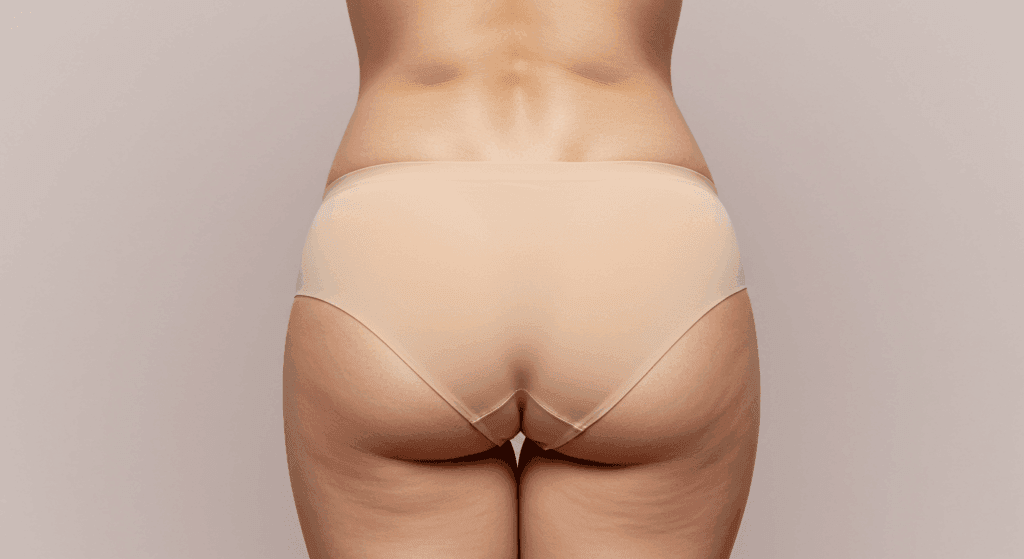Are you considering gluteal augmentation surgery but worried about the results? You’re not alone. With the rising popularity of procedures like the Brazilian Butt Lift (BBL) and buttock augmentation with implants, it’s crucial to know the signs of a successful surgery versus a poorly performed one.
This comprehensive guide will walk you through the 15 key signs that differentiate a well-executed gluteal augmentation from a subpar procedure. Whether you’re researching for yourself or a loved one, this article will equip you with the knowledge to make informed decisions and set realistic expectations.

Table of Contents
Understanding Gluteal Augmentation: What You Need to Know
Gluteal augmentation is a cosmetic procedure designed to enhance the size, shape, and projection of the buttocks. It can be performed using two primary methods:
- Fat Transfer (Brazilian Butt Lift – BBL): Fat is harvested from areas like the abdomen, thighs, or flanks via liposuction and injected into the buttocks. This method offers a more natural look and feel.
- Buttock Implants: Silicone implants are surgically placed to augment the buttocks. This method is ideal for individuals with limited fat reserves who desire significant enhancement.
Both methods have their benefits and risks, and the choice largely depends on your body type, goals, and the surgeon’s recommendation. For more details on the procedures, check out our guides on Brazilian Butt Lift and buttock augmentation with implants.
15 Signs of a Successful Gluteal Augmentation
1. Natural-Looking Results
A successful gluteal augmentation should enhance your curves while maintaining a natural appearance. The buttocks should complement your overall body proportions rather than appearing overly exaggerated or unbalanced.
2. Symmetry and Balance
Symmetry is a hallmark of a well-performed procedure. Both buttocks should be evenly shaped and sized, with no visible lumps, dents, or irregularities.
3. Smooth Contours
The contours of the buttocks should be smooth and consistent. There should be no visible ripples, dimples, or uneven areas, which can indicate poor fat transfer or implant placement.
4. Minimal Scarring
While some scarring is inevitable, a skilled surgeon will place incisions in discreet locations (e.g., within the buttock crease). Over time, scars should fade and become barely noticeable.
5. Enhanced Projection
A successful augmentation should provide a noticeable improvement in the projection of the buttocks. This means the buttocks should appear fuller and rounder when viewed from the side.
6. Comfortable Recovery
While recovery varies by individual, a successful procedure typically results in manageable discomfort that subsides within a few weeks. Severe or prolonged pain may indicate complications. For tips on optimizing your recovery, visit our Brazilian Butt Lift Recovery Guide.
7. No Signs of Infection
Redness, swelling, and mild bruising are normal in the early stages of recovery. However, signs of infection, such as excessive redness, pus, or fever, should not be present in a successful procedure.
8. Long-Lasting Results
A well-performed gluteal augmentation should provide results that last for years. For fat transfer procedures, a portion of the transferred fat may be reabsorbed, but the majority should remain intact. Implants, when properly placed, can last a decade or more.
9. Improved Confidence
One of the most rewarding signs of a successful procedure is an increase in self-confidence. Patients often report feeling more comfortable and satisfied with their appearance post-surgery.
10. Minimal Complications
A successful surgery is characterized by the absence of major complications such as fat embolism, implant displacement, or seroma (fluid buildup). Minor complications, if any, should be promptly addressed and resolved.
11. Realistic Expectations Met
A skilled surgeon will set realistic expectations during the consultation. If the results align with what was discussed pre-surgery, it’s a strong indicator of success.
12. Positive Patient Testimonials
Before and after photos, as well as patient testimonials, can provide insight into the surgeon’s expertise. Consistently positive feedback is a good sign of successful outcomes.
13. Proper Healing and Follow-Up Care
A successful procedure includes comprehensive post-operative care. The surgeon should provide clear instructions for recovery and schedule follow-up visits to monitor healing.
14. No Need for Revision Surgery
While some patients opt for touch-ups, a well-performed gluteal augmentation should not require immediate revision surgery due to errors or complications.
15. Enhanced Overall Body Proportions
The augmentation should enhance your overall body proportions, creating a harmonious and aesthetically pleasing silhouette.

15 Signs of a Poorly Performed Gluteal Augmentation
1. Unnatural or Overdone Appearance
One of the most obvious signs of a poorly performed procedure is an unnatural or overly exaggerated look. This can occur if too much fat is transferred or if implants are improperly sized.
2. Asymmetry
Asymmetrical buttocks, where one side is noticeably larger or shaped differently than the other, can indicate poor surgical technique.
3. Lumpy or Irregular Contours
Visible lumps, dents, or ripples on the buttocks are signs of uneven fat transfer or improper implant placement.
4. Excessive Scarring
While some scarring is normal, excessive or poorly placed scars can be a sign of a subpar procedure. Scars should be minimal and strategically hidden.
5. Poor Projection
If the buttocks lack projection or appear flat from the side, it may indicate insufficient fat transfer or improper implant positioning.
6. Severe or Prolonged Pain
While some discomfort is expected, severe or prolonged pain can be a red flag for complications such as infection, nerve damage, or improper healing.
7. Signs of Infection
Redness, swelling, pus, or fever are all signs of infection, which can occur if post-operative care instructions are not followed or if the surgical environment was not sterile.
8. Short-Lived Results
If the results of the augmentation diminish quickly, it may indicate poor fat survival (in fat transfer procedures) or implant displacement.
9. Dissatisfaction with Results
Feeling unhappy or dissatisfied with the results, especially if they don’t align with the expectations set during the consultation, can be a sign of a poorly performed procedure.
10. Major Complications
Complications such as fat embolism, implant rupture, or seroma are serious indicators of a poorly executed surgery. These issues require immediate medical attention.
11. Need for Revision Surgery
If revision surgery is needed shortly after the initial procedure due to errors or complications, it’s a clear sign of a subpar outcome.
12. Negative Patient Feedback
Consistently negative reviews or before-and-after photos that show poor results can indicate a surgeon’s lack of skill or experience.
13. Lack of Follow-Up Care
A surgeon who does not provide proper post-operative instructions or follow-up care may not prioritize patient safety and satisfaction.
14. Poor Communication
If the surgeon fails to communicate clearly about the procedure, risks, or recovery process, it can lead to misunderstandings and poor outcomes.
15. Unbalanced Body Proportions
A poorly performed augmentation can disrupt your overall body proportions, making your buttocks appear out of place with the rest of your figure.
| Aspect | Successful Gluteal Augmentation | Poorly Performed Gluteal Augmentation |
|---|---|---|
| Appearance | Natural-looking, balanced, and proportional | Unnatural, asymmetrical, or exaggerated |
| Contours | Smooth and consistent | Lumpy, irregular, or dented |
| Scarring | Minimal and discreet | Excessive or poorly placed |
| Projection | Enhanced and full | Flat or lacking |
| Recovery | Manageable discomfort, smooth healing | Severe pain, prolonged recovery |
| Results Longevity | Long-lasting and stable | Short-lived or diminishing quickly |
| Patient Satisfaction | High confidence and satisfaction | Dissatisfaction or regret |
| Complications | Minimal or none | Major complications requiring revision |

How to Ensure a Successful Gluteal Augmentation
1. Choose a Board-Certified Surgeon
Selecting a board-certified plastic surgeon with extensive experience in gluteal augmentation is the first step toward a successful outcome. Research their credentials, before-and-after photos, and patient reviews.
2. Set Realistic Expectations
During your consultation, discuss your goals and expectations with your surgeon. A reputable surgeon will provide honest feedback about what can realistically be achieved.
3. Follow Pre-Operative Instructions
Your surgeon will provide specific instructions to prepare for surgery, such as avoiding certain medications or maintaining a healthy lifestyle. Following these guidelines can improve your results and reduce risks.
4. Prioritize Post-Operative Care
Proper post-operative care is crucial for healing and achieving optimal results. This includes wearing compression garments, avoiding sitting directly on your buttocks, and attending all follow-up appointments. For more tips, visit our Brazilian Butt Lift Recovery Guide.
5. Maintain a Healthy Lifestyle
A balanced diet and regular exercise can help maintain your results. Avoid significant weight fluctuations, as they can affect the appearance of your buttocks.
6. Communicate Openly with Your Surgeon
If you have any concerns or questions during your recovery, don’t hesitate to reach out to your surgeon. Open communication can help address issues promptly and ensure a smoother healing process.
Conclusion
Key Takeaways
- A successful gluteal augmentation results in natural-looking, symmetrical, and proportional enhancements with minimal scarring and long-lasting results.
- A poorly performed procedure may lead to unnatural appearances, asymmetry, lumps, severe pain, and major complications.
- Choosing a qualified surgeon, setting realistic expectations, and following pre- and post-operative care instructions are essential for achieving the best outcomes.
Next Steps
If you’re ready to take the next step toward enhancing your curves, we invite you to:
- Explore our procedures: Learn more about Brazilian Butt Lift and buttock augmentation with implants.
- Consult with our experts: Schedule a consultation with our board-certified surgeons to discuss your goals and options.
- Prepare for your journey: Visit our cost and budgeting guide to plan your procedure financially.
Frequently Asked Questions
What is the difference between a Brazilian Butt Lift and buttock implants?
A Brazilian Butt Lift (BBL) uses fat transferred from other areas of your body to enhance the buttocks, providing a natural look. Buttock implants, on the other hand, involve placing silicone implants to achieve a more dramatic enhancement. The choice depends on your body type and desired outcome.
How long does it take to recover from gluteal augmentation?
Recovery times vary, but most patients can return to light activities within 2-3 weeks. Full recovery, including the ability to sit comfortably and resume intense physical activities, may take 6-8 weeks. For detailed recovery tips, visit our Brazilian Butt Lift Recovery Guide.
Are the results of gluteal augmentation permanent?
For fat transfer procedures, a portion of the transferred fat may be reabsorbed, but the majority should remain permanent. Implants can last 10-15 years or longer, but they may require replacement over time due to wear and tear.
What are the risks of gluteal augmentation?
Like any surgery, gluteal augmentation carries risks such as infection, bleeding, fat embolism, implant displacement, and scarring. Choosing a skilled surgeon and following post-operative care instructions can minimize these risks.
How much does gluteal augmentation cost?
The cost varies depending on the procedure type, surgeon’s experience, and geographic location. For a detailed breakdown, visit our Brazilian Butt Lift Cost Guide.
Can I sit after gluteal augmentation?
After surgery, you’ll need to avoid sitting directly on your buttocks for at least 2-3 weeks to protect the results. Your surgeon will provide specific instructions on how to sit safely during recovery.
How do I choose the right surgeon for gluteal augmentation?
Look for a board-certified plastic surgeon with extensive experience in gluteal augmentation. Review before-and-after photos, read patient testimonials, and schedule consultations to discuss your goals and expectations.
Will gluteal augmentation leave scars?
Scarring is inevitable, but a skilled surgeon will place incisions in discreet locations to minimize visibility. Over time, scars should fade and become less noticeable.
Our Surgeons and Affiliated Professionals
At Surgyteam, we are proud to collaborate with a distinguished team of medical professionals, each bringing a wealth of expertise and a commitment to patient-centered care.
- Dr. Mehmet Fatih Okyay (Dr. MFO): Plastic, Reconstructive and Aesthetic Surgery Specialist. Co-founder of Surgyteam. FEBOPRAS certified. (https://www.dr-mfo.com/)
- Dr. Selçuk Yılmaz: Plastic, Reconstructive and Aesthetic Surgery Specialist. (https://drselcukyilmaz.com)
- Dr. Ebru Okyay: Dermatology Specialist. (https://drebruokyay.com/)
- Dr. Mustafa Keleş: Aesthetic, Plastic and Reconstructive Surgery Specialist. (https://www.medstar.com.tr/doktorlar/mustafa-keles/)
- Dr. Boray Yücel: Plastic, Reconstructive and Aesthetic Surgery Specialist. (https://borayucel.com/)
- Dr. Sibel Atalay: Plastic, Reconstructive and Aesthetic Surgery Specialist. Clinic with International Health Tourism Authorization Certificate. (https://www.sibelatalay.com.tr/)
- Dr. Mert Meral: Plastic, Reconstructive and Aesthetic Surgery Specialist. EBOPRAS certified. (https://mertmeral.com/)
To learn more about Surgyteam and how we can assist you, please visit our website:
https://surgyteam.com/
Disclaimer: This blog post is intended for informational purposes only and does not constitute medical advice. Costs are estimates and can vary. Always consult with a qualified medical professional for personalized advice and treatment.


